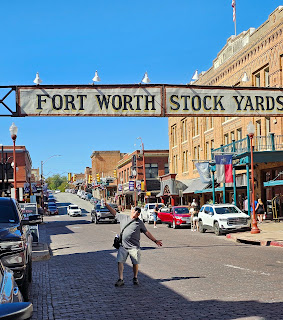Visiting relatives and The Fort Worth Stockyards
The campground was not our favorite by any means. The lake was VERY low because of the extended draught there. There were many deer walking around and it was very quiet.
Thursday night we had dinner with Rene and Troy at Riscky BBQ and had brisket and a nice visit. Friday we went to Rene and Troy's house and they took us to the Fort Worth Stockyards. FUN!!! There was a cattle drive, shops and history. We walked up and down the cobblestone streets.
We went back to their house and visited more. Rene made stuffed poppers that were excellent and I will make them too! Then she made enchilada casserole, red beans and rice and strawberry rhubarb pie for supper.
Al, Colleen, Rene and Troy. We had a very fun visit and hope to go back again for a longer stay! Thank you for your hospitality Rene and Troy!
Rene made this pie for supper and sent it with us for dessert. We ate it for breakfast on Saturday with our coffee and it was so delicious!!!
Saturday was a long 6 hour travel day! We set up and started laundry. Sunday will be more laundry and maybe a Walmart run before traveling again on Monday to Roswell. On October 27 we will be sitting still for a week before heading into Mesa for the winter. Roswell should be fun! I'll post again then! Have a great week!
A little history lesson (from https://www.fortworthstockyards.org/history)
As a drover (cattle driver) headed cattle up the Chisholm Trail to the railheads, he had one last stop for rest and supplies: Fort Worth, Texas. Beyond Fort Worth, he’d be crossing the Red River into Indian Territory.
Between 1866 and 1890, drovers trailed more than four million head of cattle through Fort Worth. The city soon became known as “Cowtown.”
When the railroad arrived in 1876, Fort Worth became a major shipping point for livestock, so the city built the Union Stockyards, two and a half miles north of the Tarrant County Courthouse, in 1887.
During World War II, the Fort Worth Stockyards processed 5,277,496 head of livestock, making 1944 the peak year of the entire operation. Unfortunately, the decline of the Stockyards soon began with the decline of the railroad.
After World War II, newly paved roads gave rise to the trucking industry, with lower costs and greater flexibility than the railroads. This meant the market moved to the shipper instead of the meat packer, and smaller local livestock auctions and feedlots started drawing business away from central locations like the Stockyards.
In 1976, Charlie and Sue McCafferty founded the North Fort Worth Historical Society to preserve Fort Worth's livestock heritage.
This new venture helped establish the Fort Worth Stockyards National Historical District and bring about the restoration of landmarks including the Livestock Exchange Building, the Coliseum and the former Swift & Co. headquarters.
In 1989, the North Fort Worth Historical Society opened the Stockyards Museum in the historic Exchange Building. Today, the museum hosts thousands of visitors from all over the world each year, and is constantly growing its facilities and its collection.
True to its history, the Stockyards still hosts the world’s only twice-daily cattle drive. All this – plus more than a hundred new shopping, dining and entertainment venues – makes the Fort Worth Stockyards National Historical District one of Texas’ most popular tourist destinations.




















1 comment:
Loved reading these experiences! Al OWNED these pics!!! :)
Post a Comment